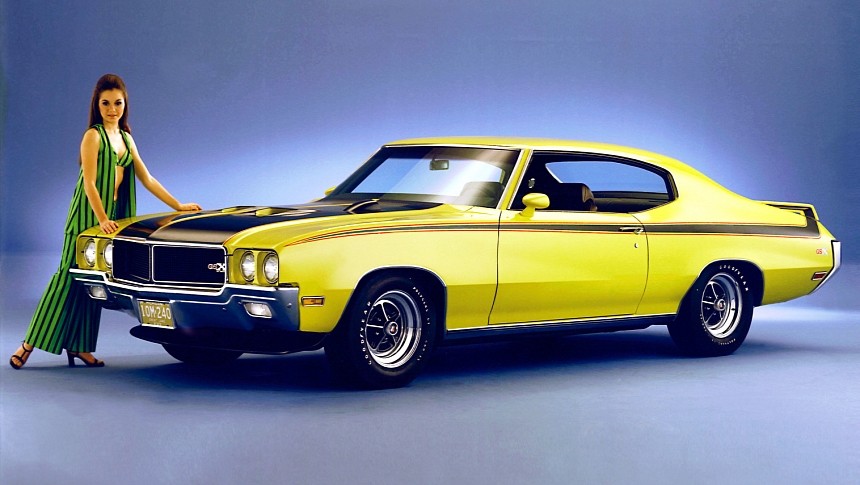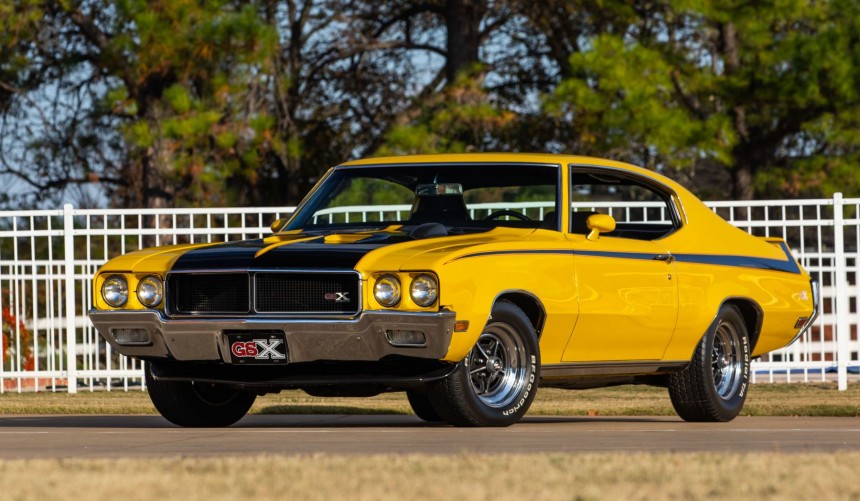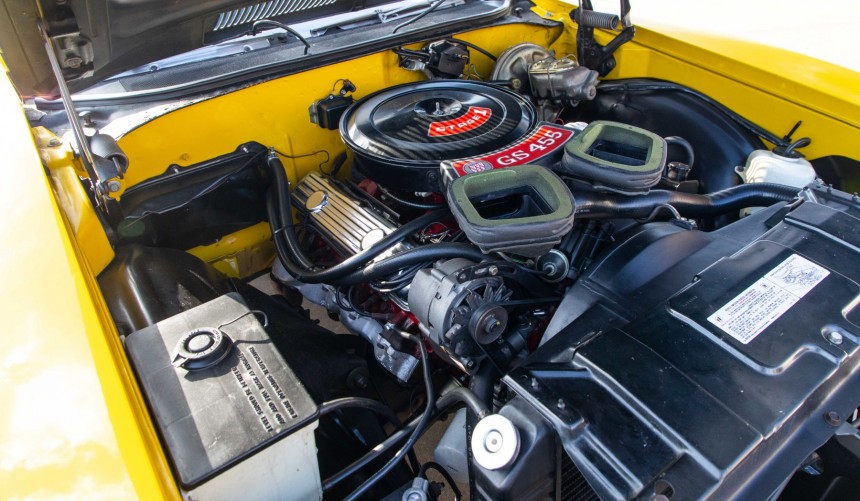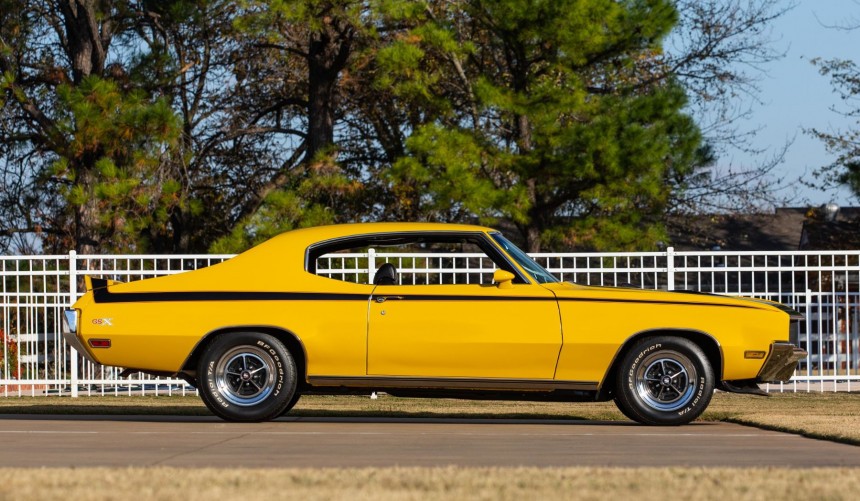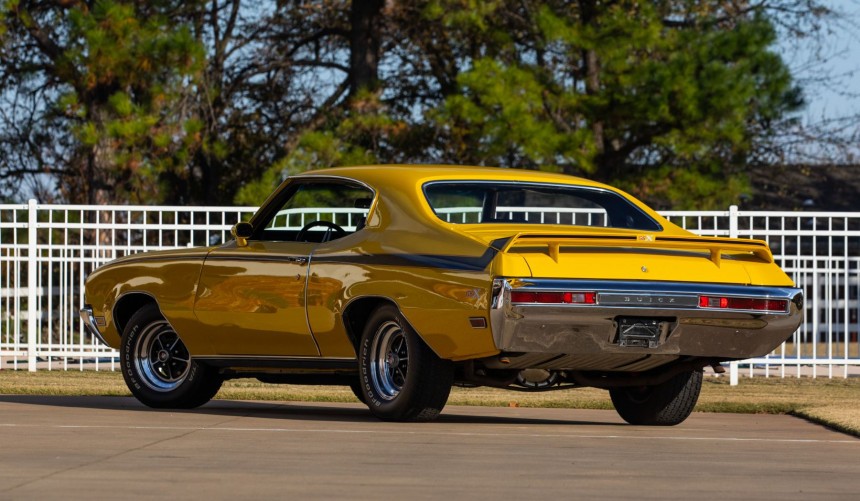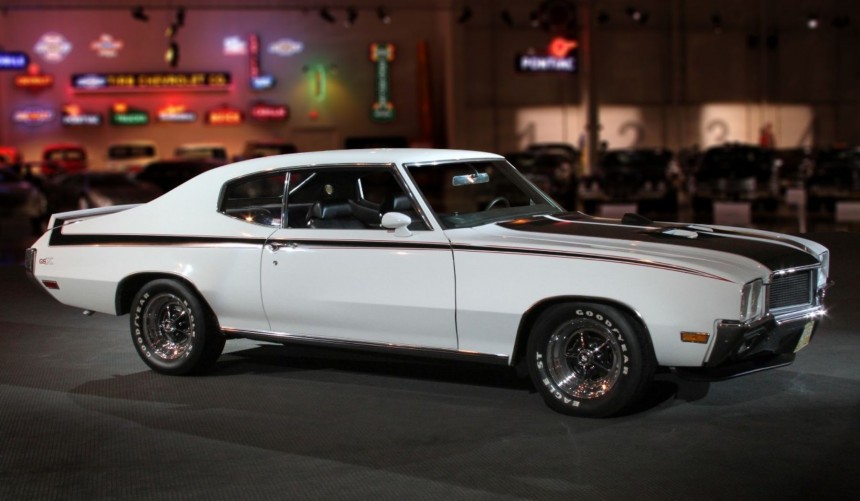Introduced during arguably the most exciting model year in American automotive history, the 1970 GSX was Buick's take on muscle car perfection.
Unlike GM siblings Pontiac and Oldsmobile, who are now part of the history books, Buick is still alive. However, its current US lineup consists of a handful of notoriously boring crossovers and SUVs.
The only thing keeping the division alive is the Chinese market, where it's surprisingly successful, with over a dozen models to choose from.
The story was quite different during the 1950s, 1960s, and 1970s when Buick was one of the biggest names in the American automotive industry.
While the division managed to do that by building an impressive range of upscale models, Buick also joined the horsepower wars with a series of excellent muscle cars. It all started in 1965 with the introduction of the Skylark Gran Sport (GS) and peaked only five years later when the GSX hit the streets.
Equipped with the Grand Sport option, the 1965 Skylark became more appealing to younger buyers, which Buick desperately needed, but since it came with a 325-hp (329 PS), 401-ci (6.6-liter) V8, it wasn't quite the heavy-hitter that the market was craving. Pontiac's GTO-spec Tempest had a base engine that produced ten additional ponies, while its optional Tri-Power could comfortably spit out 360 hp (365 PS).
Moreover, almost every muscle car available during that model year had more oomph than the Skylark GS.
Things improved in 1968 when Buick released the GS 400. As the name implies, it came with a 400-ci (6.6-liter) version of the brand's V8 that was conservatively rated at 340 hp (345 PS) in standard guise and 350 hp (355 PS) with the dealer-installed Stage 1 package. While it was a definitive improvement, the GS 400 was still far from a fan-favorite amongst muscle car enthusiasts.
The 1969 model year debuted with a factory-built GS 400 Stage 1 and an over-the-counter Stage 2 package that upped the ante to at least 360 hp (365 PS). Even with these improvements, the GS was known as the gentleman's muscle car because it maintained a somewhat sober, upscale look that was more appealing to middle-aged men and retirees who wanted a high-performance intermediate.
In 1970, GM finally lifted its notorious, self-imposed 400-ci (6.6-liter) displacement limit for intermediate models, and suddenly, its divisions were free to go all out in terms of performance.
While Chevy gave the Chevelle a massive 454-ci (7.4-liter) lump, Pontiac and Oldsmobile pulled a 455-ci ace from under their sleeves, igniting one of the most tightly-contested battles of the era's horsepower war.
Buick's weapon of choice for the Grand Sport was also a 455, which delivered more torque than any other factory-built V8 ever fitted into a muscle car.
With a fundamentally different architecture than the other two GM 455s, the new engine was rated at 350 hp (355 PS) in standard spec and 360 hp (365 PS) with the Stage 1 package that added larger valves and a hotter cam. These figures were on par with the 1969 400 V8, but the 510 lb-ft (691 Nm) of torque available as low as 2,800 rpm was unmatched.
Buick was determined to shake off the gentleman's muscle car moniker, so apart from the new GS 455, the division introduced the GSX.
A $1,196 ($9,304 today) handling and performance package available for the GS 455, the GSX became Buick's flagship muscle car and a legitimate contender for HEMI-powered intermediates, as well as its most fearsome GM siblings, the Pontiac GTO Judge, Chevrolet Chevelle SS 454, and Oldsmobile 4-4-2 W-30.
When fitted with the optional Stage 1 package, the 455-powered GSX was one of the fastest street-legal muscle cars that money could buy back in 1970. Motor Trend magazine conducted extensive tests that year and the figures achieved were impressive. Buick's lethal weapon could comfortably accelerate from 0 to 60 mph (97 kph) in 5.5 seconds and ran the quarter-mile in 13.38 seconds. It was faster than most HEMI-powered Mopars, and the only intermediate that could pose a real challenge was the LS6-powered Chevelle SS.
Available in only two distinct colors - Saturn Yellow and Apollo White - the GSX could be easily distinguished from the GS 455 thanks to its unique black decals with red pinstripes and GSX badges.
Other distinctive exterior features included bespoke front and rear spoilers, an awesome hood-mounted tachometer, and 7-inch wide wheels wrapped in Goodyear Polyglas GT rubber.
Although it looked unconventional for a Buick, the GSX was one of those mean-mugging muscle cars that looked fast even when resting in a parking lot. It was the Grand Sport that finally shook off the gentleman's muscle car mantra, and to this day, it remains the most badass-looking model that ever donned Buick badges.
The interior was more in-tune with the division's luxury-oriented tradition. It had all the creature comforts you would expect from an upscale intermediate, plus Grand Sport-exclusive features like a Rallye steering wheel, Rallye instrumentation, a pair of bucket seats, and bespoke trims.
Finally, the mechanical upgrades that came with the GSX package included power front disc brakes, a sturdier Rallye Ride Control suspension, a posi limited-slip differential, and a heavy-duty cooling package. The standard transmission was a manual four-speed, but a TH400 three-speed automatic was also available.
Although traditionally a luxury brand, Buick left its mark on the muscle car phenomenon with one of the era's most impressive models. Despite that, the 1970 GSX was never the marketing success that Buick expected. The division hoped to sell north of 1,000 units, but by the end of the model year, only 678 left its dealerships.
The GSX returned in 1971 and 1972, but the package, which could now be ordered with any GS engine, focused more on looks than performance. Many of the once-standard features like disk brakes, hood tach, or wider wheels were no longer included, and since the performance dropped for Buick's entire V8 range, the GSX sales plunged accordingly.
Thus, the 1970 iteration remains the most sought-after GSX by a large margin. Due to its awesomeness and rarity, a low-mileage example in excellent shape will demand six figures on the current collector's market. The model featured in this article's gallery sold at a Mecum auction in 2021 for $126,500, and just a year later, another one fetched $173,250. Both cars came with the four-speed manual, which is rarer and thus more desirable. Even though the manual was standard, only 199 cars were fitted with one since most buyers preferred the optional automatic.
Although it wasn't as successful as its main rivals during the 1970 model year, the GSX proved that Buick could deliver a muscle car of epic proportions. More than half a century later, it has become a muscle car icon and remains the most remarkable vehicle that Buick has ever built.
You can learn more about this fantastic car and hear its massive V8 rumble in the YouTube video below by Two Guys and a Ride.
The only thing keeping the division alive is the Chinese market, where it's surprisingly successful, with over a dozen models to choose from.
The story was quite different during the 1950s, 1960s, and 1970s when Buick was one of the biggest names in the American automotive industry.
While the division managed to do that by building an impressive range of upscale models, Buick also joined the horsepower wars with a series of excellent muscle cars. It all started in 1965 with the introduction of the Skylark Gran Sport (GS) and peaked only five years later when the GSX hit the streets.
Trial and error
Moreover, almost every muscle car available during that model year had more oomph than the Skylark GS.
Things improved in 1968 when Buick released the GS 400. As the name implies, it came with a 400-ci (6.6-liter) version of the brand's V8 that was conservatively rated at 340 hp (345 PS) in standard guise and 350 hp (355 PS) with the dealer-installed Stage 1 package. While it was a definitive improvement, the GS 400 was still far from a fan-favorite amongst muscle car enthusiasts.
The 1969 model year debuted with a factory-built GS 400 Stage 1 and an over-the-counter Stage 2 package that upped the ante to at least 360 hp (365 PS). Even with these improvements, the GS was known as the gentleman's muscle car because it maintained a somewhat sober, upscale look that was more appealing to middle-aged men and retirees who wanted a high-performance intermediate.
Buick's 455 joins the big-block party
While Chevy gave the Chevelle a massive 454-ci (7.4-liter) lump, Pontiac and Oldsmobile pulled a 455-ci ace from under their sleeves, igniting one of the most tightly-contested battles of the era's horsepower war.
Buick's weapon of choice for the Grand Sport was also a 455, which delivered more torque than any other factory-built V8 ever fitted into a muscle car.
With a fundamentally different architecture than the other two GM 455s, the new engine was rated at 350 hp (355 PS) in standard spec and 360 hp (365 PS) with the Stage 1 package that added larger valves and a hotter cam. These figures were on par with the 1969 400 V8, but the 510 lb-ft (691 Nm) of torque available as low as 2,800 rpm was unmatched.
A muscle car icon is born
A $1,196 ($9,304 today) handling and performance package available for the GS 455, the GSX became Buick's flagship muscle car and a legitimate contender for HEMI-powered intermediates, as well as its most fearsome GM siblings, the Pontiac GTO Judge, Chevrolet Chevelle SS 454, and Oldsmobile 4-4-2 W-30.
When fitted with the optional Stage 1 package, the 455-powered GSX was one of the fastest street-legal muscle cars that money could buy back in 1970. Motor Trend magazine conducted extensive tests that year and the figures achieved were impressive. Buick's lethal weapon could comfortably accelerate from 0 to 60 mph (97 kph) in 5.5 seconds and ran the quarter-mile in 13.38 seconds. It was faster than most HEMI-powered Mopars, and the only intermediate that could pose a real challenge was the LS6-powered Chevelle SS.
The most unconventional yet badass Buick ever
Other distinctive exterior features included bespoke front and rear spoilers, an awesome hood-mounted tachometer, and 7-inch wide wheels wrapped in Goodyear Polyglas GT rubber.
Although it looked unconventional for a Buick, the GSX was one of those mean-mugging muscle cars that looked fast even when resting in a parking lot. It was the Grand Sport that finally shook off the gentleman's muscle car mantra, and to this day, it remains the most badass-looking model that ever donned Buick badges.
The interior was more in-tune with the division's luxury-oriented tradition. It had all the creature comforts you would expect from an upscale intermediate, plus Grand Sport-exclusive features like a Rallye steering wheel, Rallye instrumentation, a pair of bucket seats, and bespoke trims.
Finally, the mechanical upgrades that came with the GSX package included power front disc brakes, a sturdier Rallye Ride Control suspension, a posi limited-slip differential, and a heavy-duty cooling package. The standard transmission was a manual four-speed, but a TH400 three-speed automatic was also available.
The 1970 GSX today
The GSX returned in 1971 and 1972, but the package, which could now be ordered with any GS engine, focused more on looks than performance. Many of the once-standard features like disk brakes, hood tach, or wider wheels were no longer included, and since the performance dropped for Buick's entire V8 range, the GSX sales plunged accordingly.
Thus, the 1970 iteration remains the most sought-after GSX by a large margin. Due to its awesomeness and rarity, a low-mileage example in excellent shape will demand six figures on the current collector's market. The model featured in this article's gallery sold at a Mecum auction in 2021 for $126,500, and just a year later, another one fetched $173,250. Both cars came with the four-speed manual, which is rarer and thus more desirable. Even though the manual was standard, only 199 cars were fitted with one since most buyers preferred the optional automatic.
Although it wasn't as successful as its main rivals during the 1970 model year, the GSX proved that Buick could deliver a muscle car of epic proportions. More than half a century later, it has become a muscle car icon and remains the most remarkable vehicle that Buick has ever built.
You can learn more about this fantastic car and hear its massive V8 rumble in the YouTube video below by Two Guys and a Ride.
